Safe Pest Control For Indoor Plants: A Complete Guide

Indoor plants add beauty, color, and even a little freshness to your living space. But nothing spoils the joy faster than spotting pests sneaking around your favorite greenery. These tiny invaders not only damage leaves and roots but also cause stress for anyone who loves their plants. The great news is you don’t need harsh chemicals to win the battle. There are safe, natural ways to protect your indoor plants while keeping your family, pets, and environment out of harm’s way.
Back when I worked as an interior plantscape designer for luxury resorts and private homes, I faced my share of indoor pest problems. I’ve seen firsthand how plants can recover with the right care—and how satisfying it is to watch stubborn insect pests disappear.
In this guide, I’ll share safe pest control solutions, smart prevention tips, and a simple checklist to keep your indoor garden happy and thriving.
Why Safe Pest Control Matters
When pests attack indoor plants, many people reach for chemical sprays. While effective, these products often contain toxic ingredients. These chemicals can linger in your home, hurting air quality and posing serious risks to kids’ and pets’ health.
Instead, safe pest control methods focus on natural solutions. They target the pests without harming the plant or your living space. Safe options also promote healthier growth, as plants are not exposed to unnecessary stress from chemicals.
By choosing natural pest control, you protect your plants, your health, and the environment all at once.
Common Pests That Attack Indoor Plants
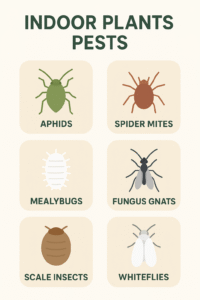
Before learning how to get rid of them, it helps to know your enemy. These are the most common indoor plant pests to keep a watch for:
-
Aphids – Tiny, soft-bodied insects that suck sap from leaves and stems.
-
Spider mites – Are microscopic pests that leave fine webbing on the leaves of indoor plants.
-
Mealybugs – Small, white, cotton-like insects that hide in leaf joints.
-
Fungus gnats – Little black flies that breed in damp soil.
-
Scale insects – Brown, shell-like bugs that cling to stems and leaves.
-
Whiteflies – Small white flying insects that weaken plants by sucking sap.
Each pest has its own habits, but most can be treated with safe, natural solutions.
Safe Pest Control Methods for Indoor Plants
1. Neem Oil Spray
Neem oil is a natural pesticide made from the neem tree. It disrupts pest growth and feeding while being safe for people and pets. Mix one teaspoon of neem oil with water and a few drops of mild soap. Spray on the leaves once a week until pests are gone.
2. Insecticidal Soap
Homemade insecticidal soap is gentle but effective. Mix several drops of liquid dish soap with water. Spray it directly on pests like aphids, mealybugs, and whiteflies. The soap breaks down the insects’ protective coating, causing them to dehydrate.
3. Rubbing Alcohol Solution
For mealybugs and scale, dab a cotton swab in rubbing alcohol and apply it directly to the host insect pests. This dissolves their protective coating and kills them quickly.
4. Diatomaceous Earth
This natural powder is made from fossilized algae. Sprinkle it on the top layer of soil to kill crawling insects. The powder damages pests’ exoskeletons, but it’s safe for people and pets when used correctly.
5. Sticky Traps
Sticky yellow traps work well against fungus gnats and whiteflies. Place them near your plants to catch flying insects.
6. Beneficial Insects
Ladybugs and lacewings can be introduced indoors to eat pests like aphids. While not always practical in small homes, they are great for larger greenhouses or sunrooms.
7. Cinnamon Powder
Cinnamon is a natural antifungal and can help with fungus gnat larvae in soil. Sprinkle a light layer on top of the soil to reduce breeding.
8. Garlic Spray
Blend garlic with water to make a natural pest repellent. Strain this mixture and apply/spray it on the plant leaves. Garlic’s strong smell deters many insects.
Preventing Pests on Indoor Plants
It’s easier to prevent pest infestation than to fight this issue later if it grows out of control. Use these prevention tips:
-
Inspect new plants before bringing them inside.
-
Quarantine new plants for at least two weeks.
-
Avoid overwatering, as damp soil attracts fungus gnats.
-
Wipe plant leaves with a damp cloth to remove dust and pests.
-
Keep plants healthy with proper light and nutrition.
-
Regularly check under leaves and around soil.
Healthy plants are much less likely to suffer from severe pest problems.
Safe Pest Control Checklist for Indoor Plants
Here’s a quick checklist you can use to keep pests under control:
✅ Inspect plants weekly for pests.
✅ Clean leaves with a damp cloth.
✅ Use sticky traps for flying insects.
✅ Apply neem oil or insecticidal soap if pests are spotted.
✅ Treat soil with cinnamon or diatomaceous earth if needed.
✅ Quarantine all new plants before adding them to your plant collection or plant design.
✅ Avoid overwatering to prevent fungus gnats.
✅ Rotate natural treatments to keep pests from returning.
Keep this checklist handy to stay on top of plant care.
FAQs About Safe Pest Control for Indoor Plants
1. What is the safest way to remove pests from indoor plants?
The safest methods include neem oil, insecticidal soap, and rubbing alcohol. These natural solutions work without harming your plant or indoor environment.
2. Can I use vinegar on indoor plants to kill pests?
Vinegar can harm plant leaves if used directly. It’s better for cleaning pots and surfaces, not for spraying on living plants.
3. How do I know if my plant has pests?
Look for signs like yellowing leaves, sticky residue, fine webbing, or small crawling insects. Regular inspection is key.
4. Are chemical sprays safe for indoor use?
Many chemical sprays release harmful fumes. It’s best to avoid them indoors, especially around children or pets.
5. Can coffee grounds control indoor plant pests?
Coffee grounds can deter some insects, but they may also attract fungus gnats if the soil stays damp. Use with caution.
6. Can pests spread from one indoor plant to another?
Yes, pests often move between plants. Quarantine infested plants until the problem is solved.
7. How often should I use neem oil on my plants?
Spray neem oil once a week during an infestation. For prevention, apply every two to three weeks.
8. What’s the best way to stop fungus gnats in houseplants?
Let the soil dry out between waterings, use sticky traps, and sprinkle cinnamon or diatomaceous earth on the soil surface.
9. Are there pet-safe pest control options for indoor plants?
Yes! Neem oil, insecticidal soap, cinnamon, and sticky traps are all safe around pets when used properly.
10. Should I throw away a plant if it’s infested?
Not always. Most infestations can be treated with safe methods. Only consider discarding your plant/plants if the pest problem is severe and spreading.
Conclusion
Safe pest control for indoor plants is not only possible—it’s highly effective. By using natural remedies like neem oil, insecticidal soap, and cinnamon, you can protect your plants without risking your health or your pets’ safety. Prevention is equally important. Regular inspections, proper watering, and a simple checklist can save you from major pest problems.
Your indoor garden deserves care without chemicals. With these safe methods, your plants will stay healthy, vibrant, and pest-free all year round.
✨ Pro Tip: Bookmark this guide and use the checklist every week to keep your indoor jungle thriving!

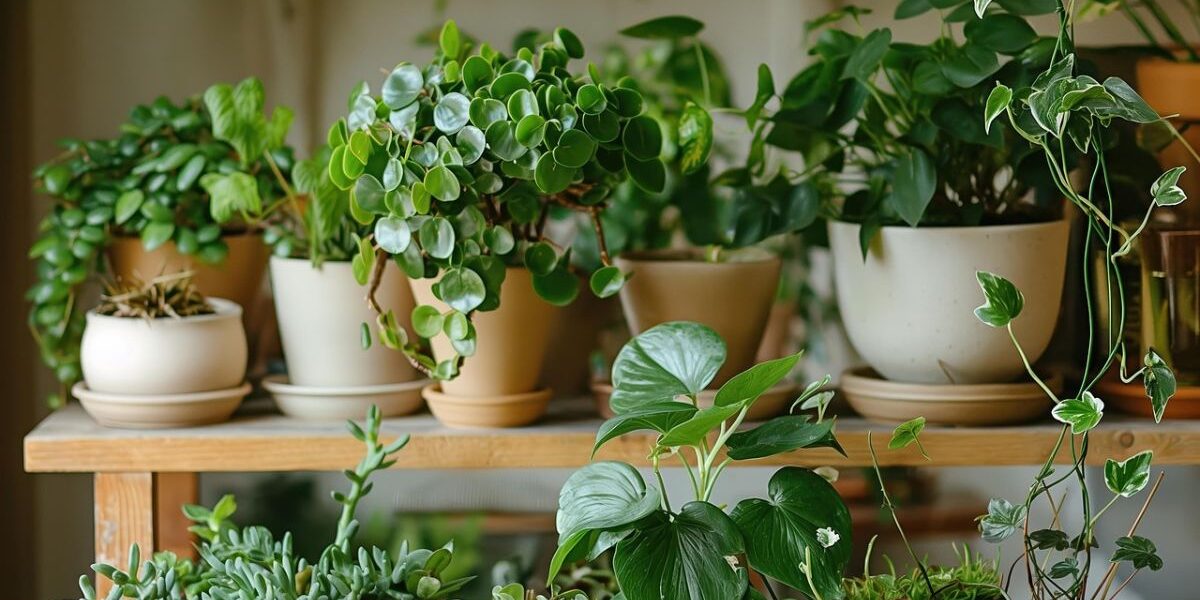

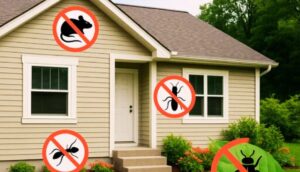
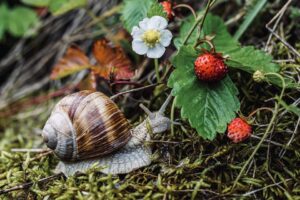
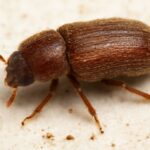
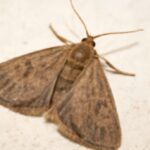
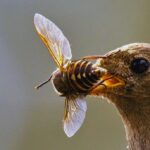
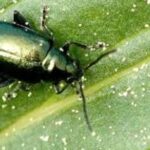
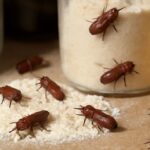
Great read, I like how you broke things down into practical steps instead of just saying use natural methods. I’ve had fungus gnats before, and I can confirm sticky traps plus letting the soil dry out really does the trick. I never thought about using cinnamon though that’s a new tip i can try in the future.
One thing I’d add from my experience is checking the drainage holes too. Sometimes pests hide there, and it’s easy to miss if you only look at the leaves and topsoil. Do you find neem oil works better as a preventive measure or only once there’s already an infestation?
Neem oil is a handy tool for keeping indoor pests under control. It works best as a preventative when you use it regularly, but it can also help tackle active infestations. If you notice pests starting to show up, it’s important to treat them early—weekly applications can stop a small issue from turning into a big problem. For prevention, spraying every two weeks is usually enough to keep your plants healthy and pest-free.